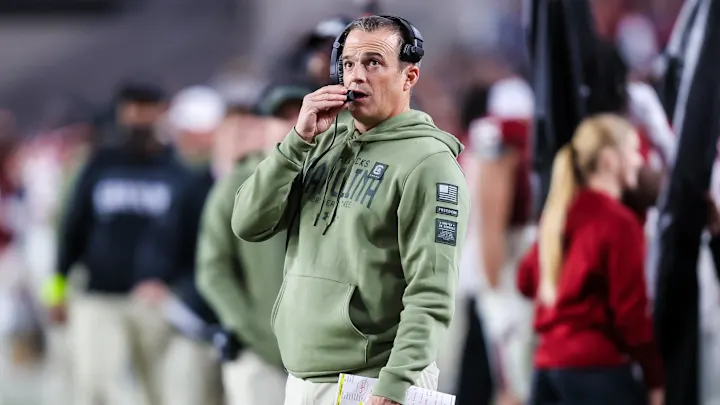Shane Beamer, the head coach of South Carolina, explains why the spring game won’t air on television.

South Carolina Head Coach Shane Beamer Explains Why Spring Game Won’t Be On TV
The University of South Carolina’s football program, under the leadership of head coach Shane Beamer, has garnered significant attention in recent years, with a clear focus on building a competitive and successful team. As the Gamecocks prepare for the 2025 season, many fans have been eager to get a glimpse of the team’s progress during the spring game, a staple event that showcases the talent and development of players ahead of the new season. However, a notable decision has raised eyebrows among fans, as it was announced that this year’s spring game will not be broadcast on television, leaving many wondering about the rationale behind this choice.
In an interview following the announcement, Shane Beamer took the opportunity to explain the reasoning behind this decision. For many, the spring game is an opportunity to witness firsthand the strategies, new recruits, and team dynamics in action. With the increasing popularity of college football and the massive fan base the Gamecocks have, the decision to forgo a television broadcast of the event surprised many. Nevertheless, Beamer’s explanation provides insight into the decision-making process and offers fans a deeper understanding of how the coaching staff and athletic department approach the offseason.
The Importance of the Spring Game
Before diving into Coach Beamer’s reasoning, it’s important to understand the role of the spring game in college football. Spring games are typically held after the conclusion of spring practices, which usually take place in March or April. These games are a low-stakes opportunity for teams to showcase their talents, try out new plays, and allow coaches to assess the progress of players throughout the spring practice period.
For fans, the spring game is an event that can bring hope and excitement for the upcoming season. While these games are often informal and sometimes more like scrimmages than competitive matchups, they offer a preview of what the team will look like in the fall. It’s a chance for players to show their skills in front of the home crowd, and for the coaching staff to identify areas of improvement before the summer training camp begins.
In recent years, spring games have grown in importance not only for the team but also for the fan base. Many schools, including South Carolina, have used these events as an opportunity to engage with the community, attract recruits, and build excitement around the program. Television broadcasts of spring games have become more common, allowing fans who cannot attend in person to experience the event and get a glimpse of their team’s development.
Why the Spring Game Won’t Be on TV: Shane Beamer’s Explanation
When Shane Beamer announced that the South Carolina spring game would not be televised, it prompted questions from fans, media, and analysts. The decision to forgo a TV broadcast is not common in modern college football, where broadcasting deals are a significant part of a school’s revenue and media strategy. Beamer, however, explained that this decision was not about avoiding exposure but rather about taking a more measured approach to the event.
1. Focus on Player Development and Evaluation
One of the primary reasons Beamer cited for not televising the spring game was the desire to keep the focus on player development and evaluation. In the early stages of a program’s development, it’s crucial for the coaching staff to create an environment where players are free to experiment and make mistakes without the pressure of public scrutiny. The absence of a TV broadcast would allow Beamer and his staff to assess players in a more authentic setting, free from the external distractions that come with a televised event.
“For us, the spring game is a developmental opportunity, not a spectacle,” Beamer explained. “We want to evaluate our players in a competitive environment, but we also want them to feel comfortable trying things out. The last thing we want is for players to feel like they’re being judged on every single play, especially when we’re still figuring things out as a team.”
Televising the spring game could introduce an element of pressure that might detract from the coaching staff’s ability to make honest assessments of the team. By keeping the game off television, Beamer is ensuring that the players are not overly concerned with how they are perceived, focusing instead on learning, improving, and executing the system that will be essential to their success in the upcoming season.
2. Internal Focus Over External Perception
Another reason Beamer gave for not televising the spring game was his commitment to fostering an internal focus over external perception. While the spring game is a fan-driven event, Beamer emphasized that his primary responsibility is to the players, coaches, and the program as a whole. The Gamecocks are in a phase of building and refining their team culture, and the coach believes it’s crucial to avoid placing too much importance on the optics of a spring game.
“Right now, we’re in a phase of building our program from the ground up,” Beamer said. “We don’t need the external pressures of a televised game to dictate how we approach things. Our focus is on development and internal improvement, not on appeasing fans or pleasing the media. We have a long-term vision for this program, and we have to stay focused on that.”
Beamer’s comments reflect his philosophy of prioritizing player development and team cohesion over public perception. In many ways, this decision mirrors his overall approach to coaching—emphasizing hard work, discipline, and a commitment to the long-term success of the program, rather than focusing on short-term gains or external validation.
3. Encouraging In-Person Attendance and Fan Engagement
While the decision not to televise the spring game may have disappointed some fans, Beamer highlighted an important aspect of the Gamecocks’ spring game experience: fan engagement. By not broadcasting the event, the Gamecocks are encouraging fans to attend in person, providing an opportunity for the fan base to connect directly with the team and create an electric atmosphere in Williams-Brice Stadium.
“The best way to experience the spring game is in person,” Beamer said. “It’s an opportunity for our fans to see the team up close, cheer on the players, and engage with the program. The energy we get from the crowd at Williams-Brice is something that’s really special. I want our fans to be part of the process, not just watch it from their living rooms.”
Beamer’s commitment to in-person fan engagement is a smart move that will likely pay dividends in the long run. College football is a community-driven sport, and the Gamecocks have one of the most passionate fan bases in the country. By encouraging fans to attend the spring game, Beamer is reinforcing the connection between the team and the community, which can only strengthen the program moving forward.
4. Strategic Privacy Ahead of the Season
A more tactical consideration in Beamer’s decision involves the privacy of the team’s strategies. Spring games are typically an opportunity for coaches to experiment with new systems, formations, and players in various roles. By keeping the event off television, Beamer and his staff are able to keep any innovations or new strategies under wraps, ensuring that opponents won’t have access to critical game plans ahead of the fall season.
“I want to keep things close to the vest,” Beamer stated. “The spring game gives us a chance to test new ideas, try out different players in different positions, and refine our playbook. I don’t want to give away too much to our opponents, and not having the game on TV helps us maintain some strategic privacy.”
In an age where college football teams are constantly analyzing and reviewing game film, keeping strategies hidden from rival schools is a key element of maintaining a competitive edge. While the spring game is a low-stakes event in terms of wins and losses, the tactical decisions made during the game could have implications for the upcoming season. By keeping these strategies private, Beamer is ensuring that his team’s competitive advantage remains intact.
The Future of Spring Games and Media Exposure
While the decision to forgo television coverage for the spring game may be specific to the 2024-2025 season, it’s clear that the landscape of college football media rights and exposure is constantly evolving. The NCAA and various conferences continue to explore new ways to broadcast games, engage with fans, and monetize athletic programs. However, Beamer’s decision reflects a broader shift in the approach to team-building and player development—prioritizing internal growth and team cohesion over external validation.
For Gamecocks fans, this decision may take some getting used to, especially given the increasing prominence of television broadcasts in college sports. However, it’s clear that Beamer’s focus remains on building a sustainable and successful program for the future, one that values development and long-term success over the short-term spectacle.









